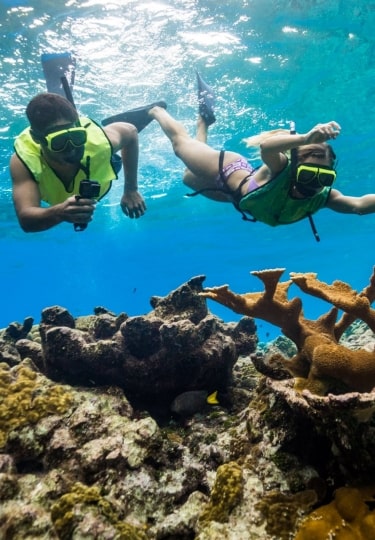Discover the best snorkeling in the Caribbean, where you’ll find colorful marine life, perfect weather, and ideal conditions.
Most of the islands have minimal currents near shore and excellent visibility, so you can often see for 100 feet or more underwater. People who have snorkeled before, of course, already know how excellent Caribbean snorkeling is across all islands and countries, but first-timers are in for a breathtaking experience.
Here are some of the top Caribbean snorkeling sites and what to expect at each one.
De Palm Island, Aruba
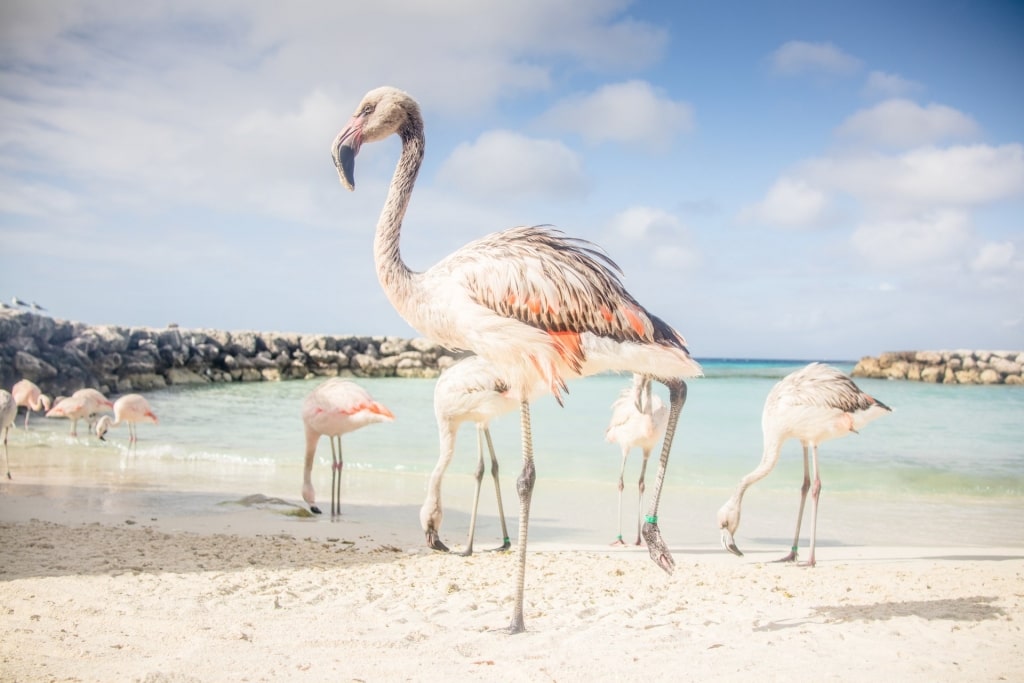
De Palm Island, Aruba
If snorkeling is on your agenda in Aruba, head to De Palm Island, a private island resort just off the mainland. While the island resort offers everything from a tropical restaurant to waterslides, the highlight here is the reef just offshore.
It’s crystal clear and has a shallow slope, so first-time snorkelers can see fish in water less than three feet deep. You can snorkel on your own or join along on one of the resort staff’s complimentary daily tours. A visit to Aruba is not complete without seeing the famously colorful parrotfish, and you can spot them on the reef around De Palm.
Bonaire National Marine Park, Bonaire
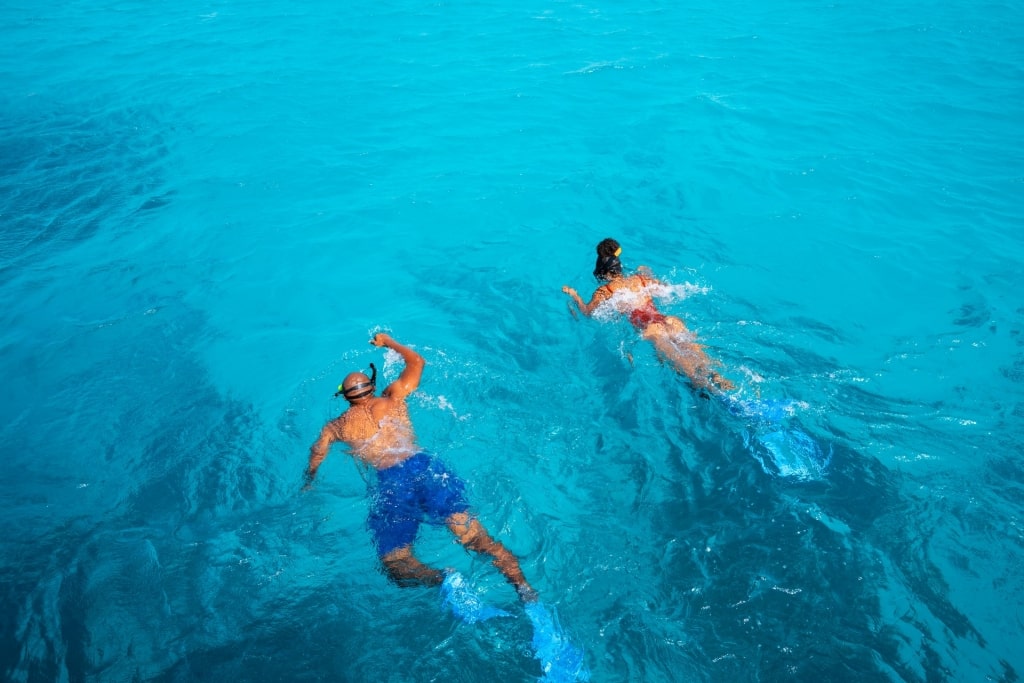
Bonaire National Marine Park, Bonaire
Dedicated scuba divers know that Bonaire is among the best scuba diving locations in the world. Fortunately for snorkelers, this means the island boasts some of the best snorkeling in the Caribbean, such as the Bonaire National Marine Park. This site covers more than 6,700 thousand acres and is home to more than 340 fish species and healthy populations of endangered sea turtles.
As Bonaire offers some of the best snorkeling in the world, you can enter the water almost anywhere off the island. Although, you’ll have the best luck spotting sea turtles if you book a boat tour that will take you to some of the best sandy-bottom spots, most of which are just a bit too far offshore to reach by swimming.
Caracas Bay, Curaçao
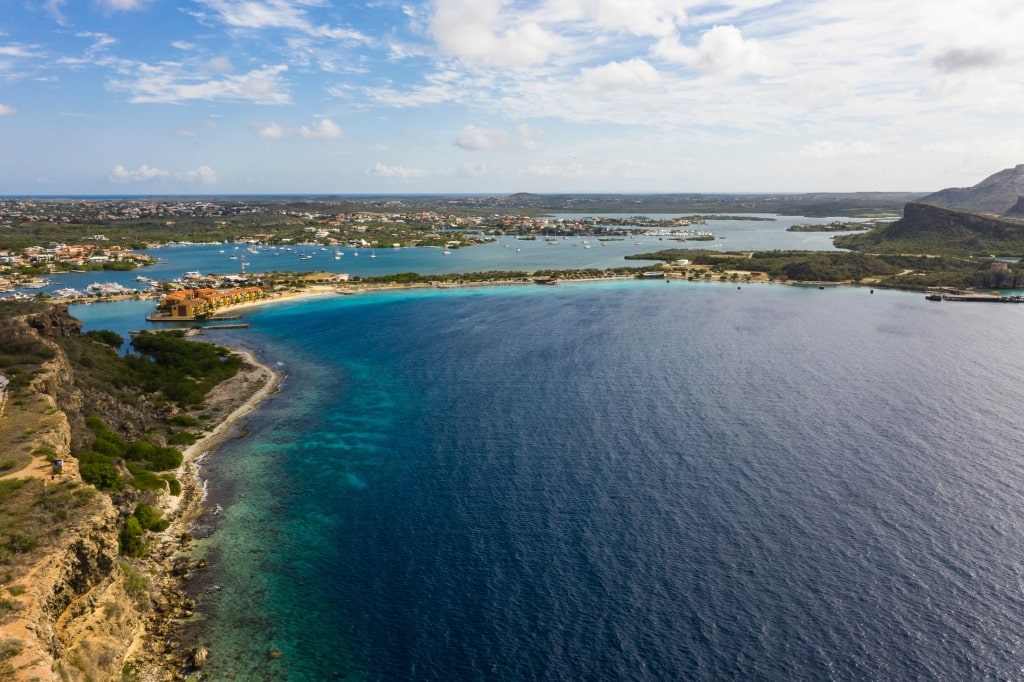
Caracas Bay, Curaçao
Just a few hours away from Bonaire is Curaçao, the third island of the three that make up the ABC Islands (Aruba and Bonaire are the other two).
Some of the best snorkeling in Curaçao is found at Caracas Bay. That’s where you’ll find a sunken tugboat covered in colorful coral, fish, and crabs. If you like shipwrecks, you’ll certainly think this is among the best snorkeling in the Caribbean since the tugboat is no more than 15 feet deep—and very well preserved.
Cozumel National Marine Park, Mexico
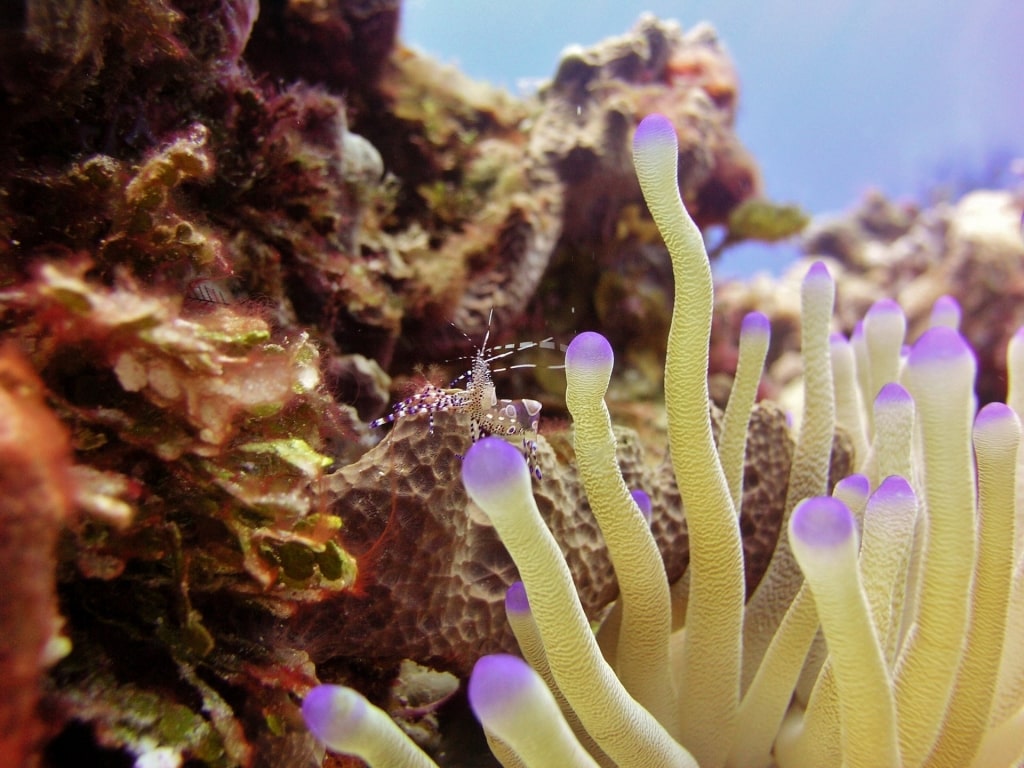
Cozumel National Marine Park, Mexico
Cozumel is another highly regarded global destination for snorkelers, scuba divers, and freedivers. There are hundreds of places to get in the water here, but two are especially well-known among snorkelers: The Cozumel National Marine Park and Punta Sur Eco Beach Park.
Head to the marine park if you want an all-day Cozumel snorkeling adventure. Most snorkeling trips travel between sites via catamaran, stopping in different areas known for various rare creatures or schooling fish. The park is huge, so trips that stop at three or more sites usually include a tropical lunch and drinks and snacks throughout the day.
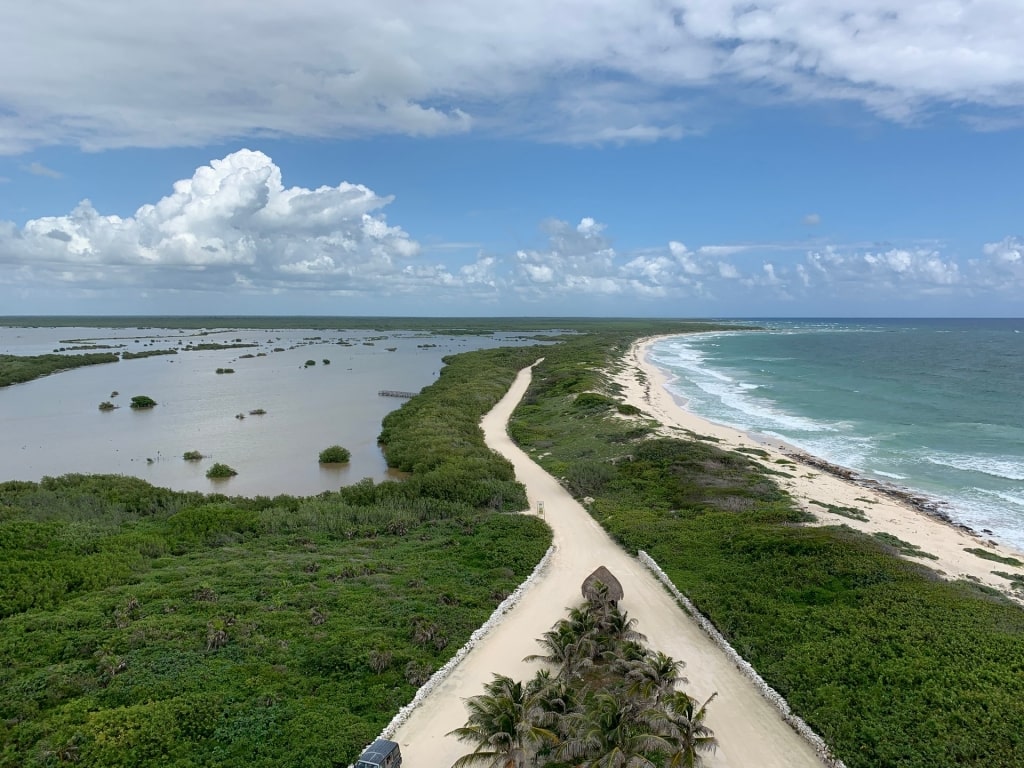
Punta Sur Eco Beach Park in Cozumel, Mexico
As one of the best beaches in Cozumel, expect to find crystal-clear snorkeling at Punta Sur Eco Beach Park. It’s a top spot for first-time snorkelers as the beach features a sandy bottom, gentle waves, and small schools of fish—you won’t see any sharks here.
It’s also a great spot if you have non-snorkelers with you since the park features Mayan ruins, a spa, a restaurant, and kayak rentals. There’s plenty to do here in between snorkel sessions (though you may find yourself never wanting to come out of the water).
Turtle Bay, Barbados
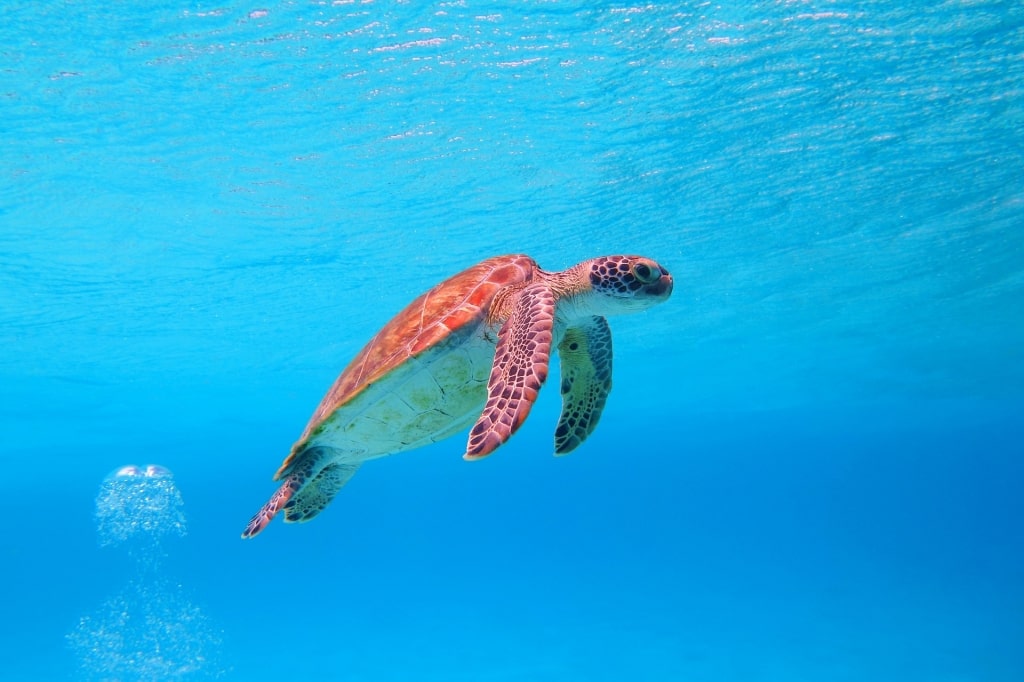
Turtle Bay, Barbados
Is there anything more magical than swimming alongside 100-year-old sea turtles in bright blue water? If that’s your idea of a perfect day, head to Turtle Bay in Barbados, one of the best Caribbean snorkeling sites.
The bay is a feeding area for turtles, so they’re almost always in the area. The water is shallow—feel free to hold your breath and dive in for a chance to swim next to turtles enjoying the plentiful marine grass. Just remember to give them plenty of space so they don’t feel crowded.
Sapphire Beach, St. Thomas
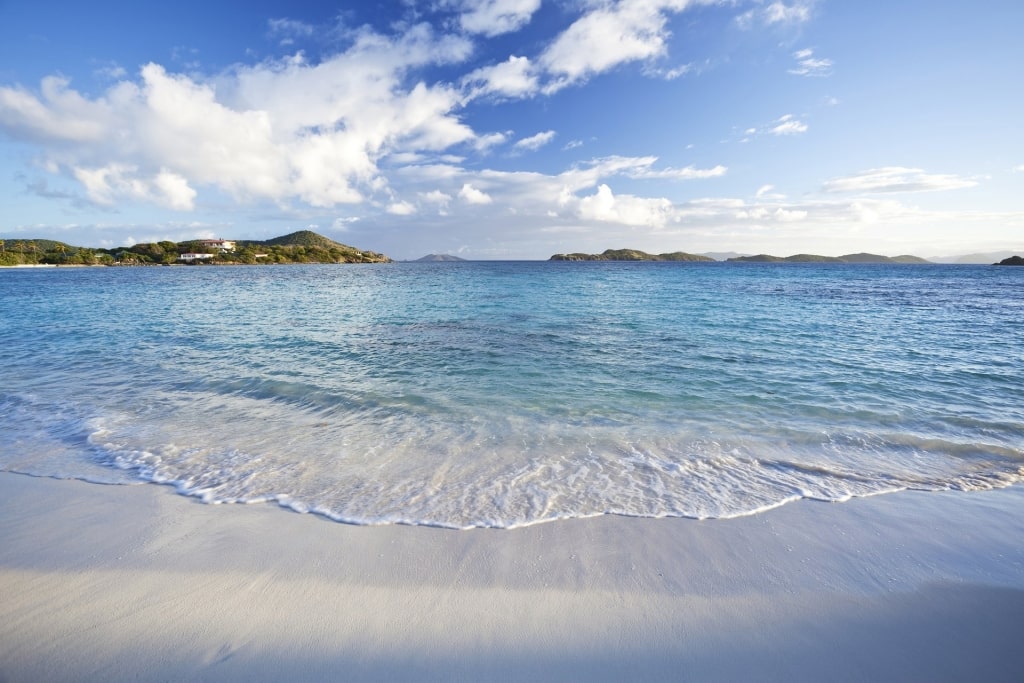
Sapphire Beach, St. Thomas
Sapphire Beach in St. Thomas is just as pretty as it sounds, and that goes for both the above and underwater worlds. Not only is it home to some of the best snorkeling in the Caribbean, but it also has a wide sandy beach, so you can relax in a lounger with a cocktail in hand between snorkel sessions.
While snorkeling, you won’t have to go far to glimpse the underwater world. The reef is just 50 or so feet off the beach, and the large patches of seagrass just a bit further than that tend to attract sea turtles and the occasional baby stingray or nurse shark.
Read: Best Things to Do in St. Thomas
Buck Island, St. Croix
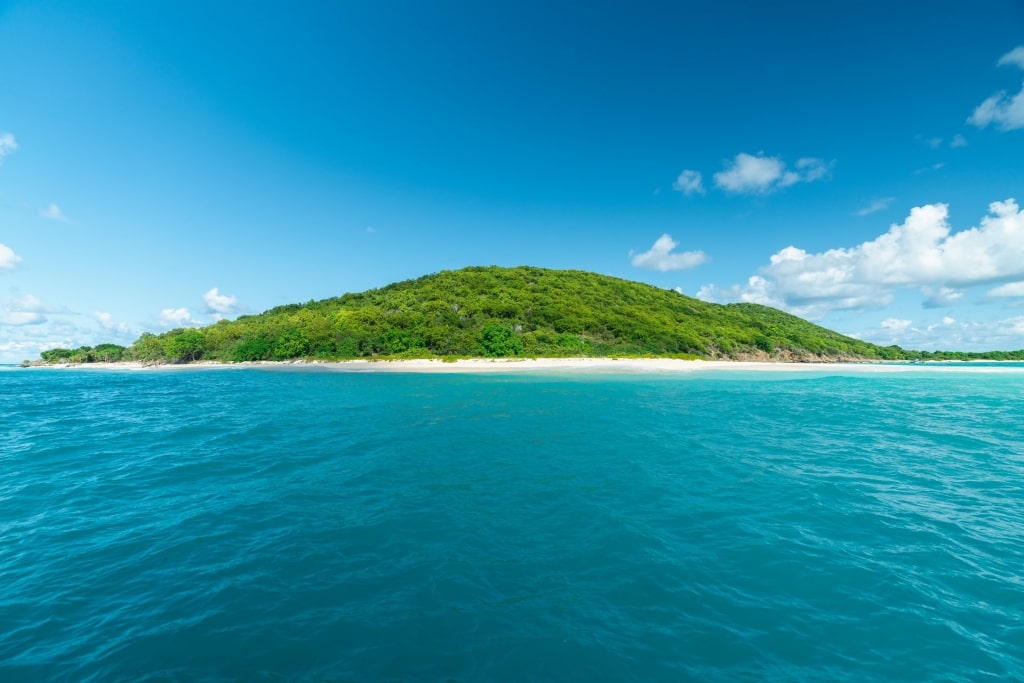
Buck Island, St. Croix
In St. Croix, part of the U.S. Virgin Islands, you’ll find excellent snorkeling at Buck Island National Monument. The underwater site is so amazing that it’s protected by the U.S. Park Service.
Here, you can follow an underwater snorkel trail through the Caribbean coral reef, where underwater plaques share information about the coral and creatures you’re likely to see. There are also coral grottos, which are formations of huge elkhorn coral that create what looks like underwater canyons.
Creole Rock, St. Maarten
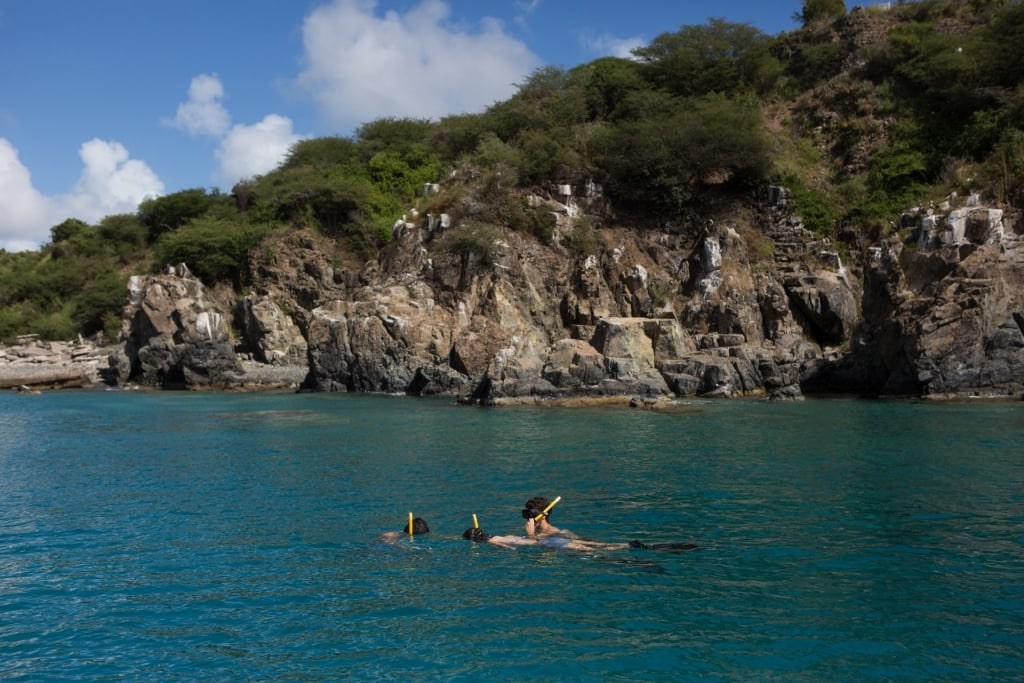
Creole Rock, St. Maarten
If your vacation plans have you headed to St. Maarten, set aside a day to visit the French side of the island, St. Martin, and Creole Rock. The rocky island is encircled by a fabulous reef, which attracts plenty of baby fish and larger species eager to feed on them.
Though it’s one of the most popular locations for Caribbean snorkeling on the island, the reef is large enough that it’s fairly easy to avoid the crowds.
Read: Best Scuba Diving in St. Maarten
Pigeon Island National Park, St. Lucia
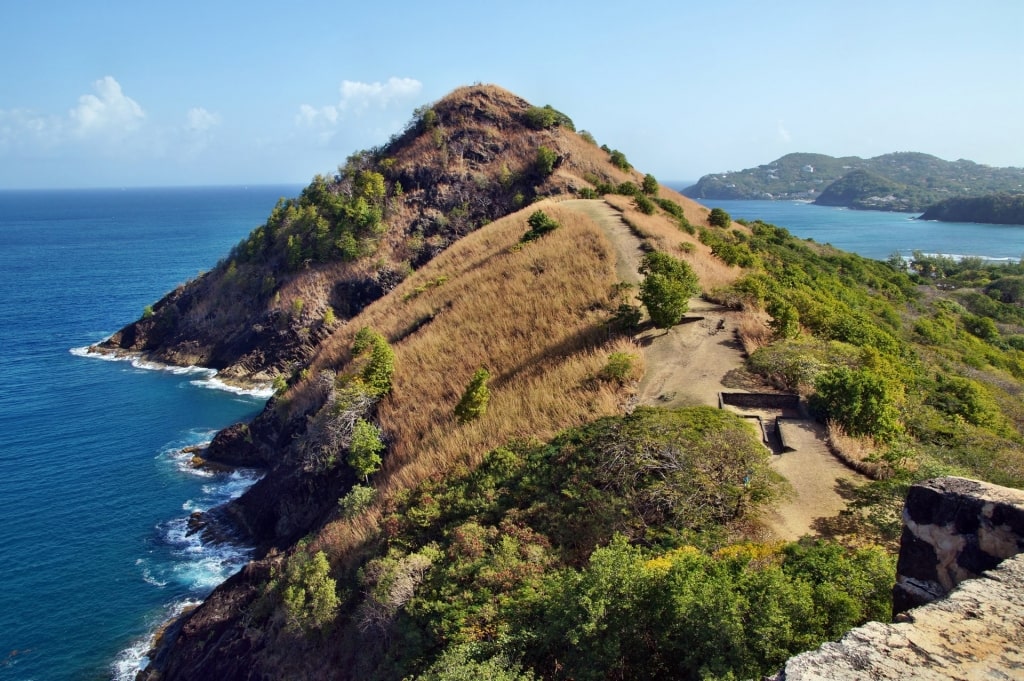
Pigeon Island National Park, St. Lucia
St. Lucia is one of the most beautiful islands in the region, so it’s just the icing on the cake that it offers some of the best snorkeling in the Caribbean, too. For a dream experience, head to Pigeon Island.
Five hundred different fish species have been spotted in the island’s reefs, including everything from rainbow parrotfish to pink-and-yellow Spanish hogfish to the ornate spotted scorpionfish. If there was ever a place to carry a fish ID chart with you in the water, Pigeon Island is it.
Read: Things to Do in St. Lucia
Escambrón Marine Park, Puerto Rico
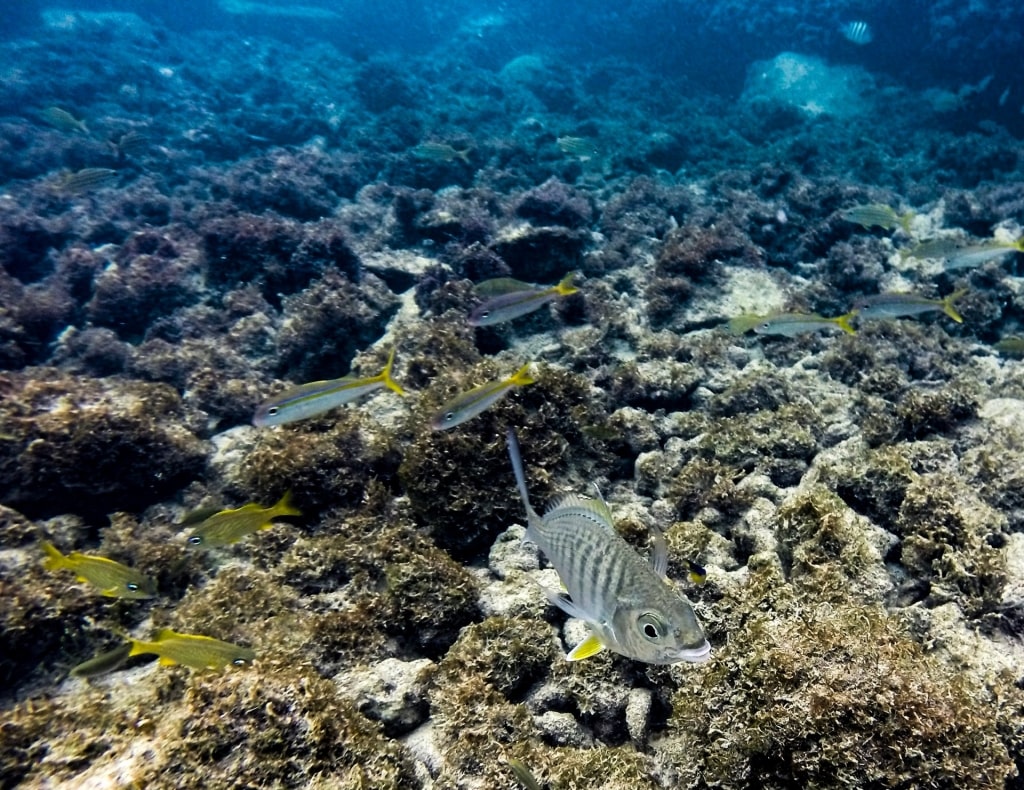
Escambrón Marine Park, Puerto Rico
The world-famous Escambrón Marine Park in Puerto Rico offers some of the best snorkeling in the Caribbean for people who love taking underwater photos.
Thanks to intentionally sunken statues and columns, there’s a whole “ancient” city underwater here, as well as more than 200 artificial reefs, making it one of the best places to snorkel in Puerto Rico. These provides plenty of places for fish and sea creatures to live, so the park has its own mini-habitat.
Cades Reef, Antigua
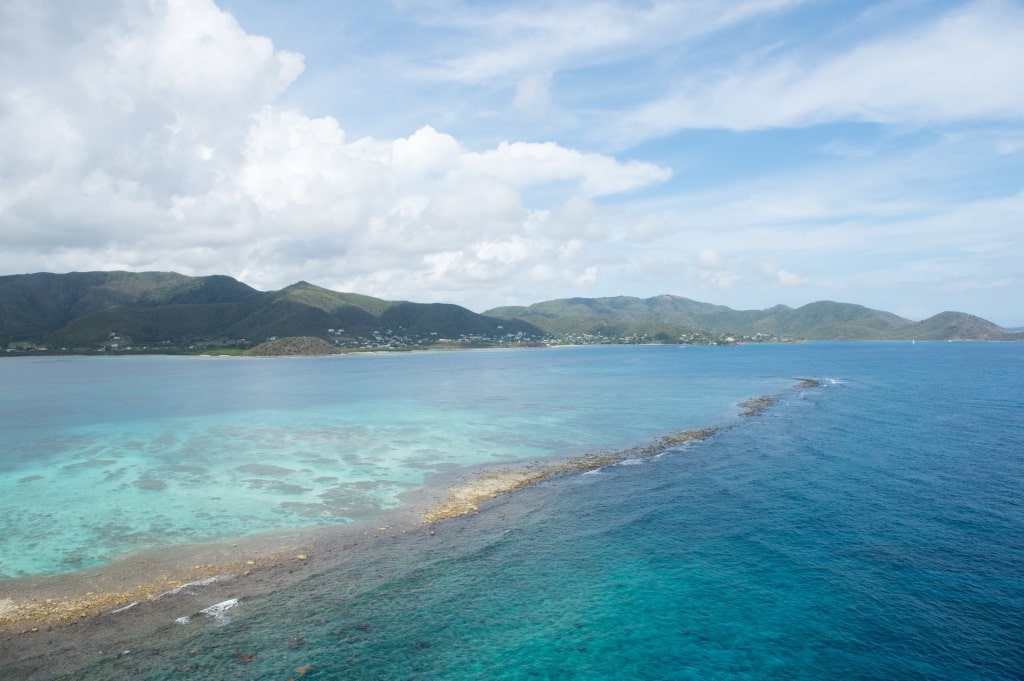
Cades Reef, Antigua
Cades Reef is one of Antigua’s best snorkeling spots, partially because the visibility is exceptional. It’s not unusual to be able to see for well over 100 feet underwater, making it ideal for both first-time snorkelers who want to keep an eye on everything around them and seasoned snorkelers on the lookout for rare fish.
Most snorkelers stay on the protected side of this cove in Antigua, where currents and waves are non-existent. There’s plenty to see here—parrotfish, eels, and rays are common, and if you’re lucky, you may even see a small reef shark or two near the ocean floor.
Green Island, Antigua
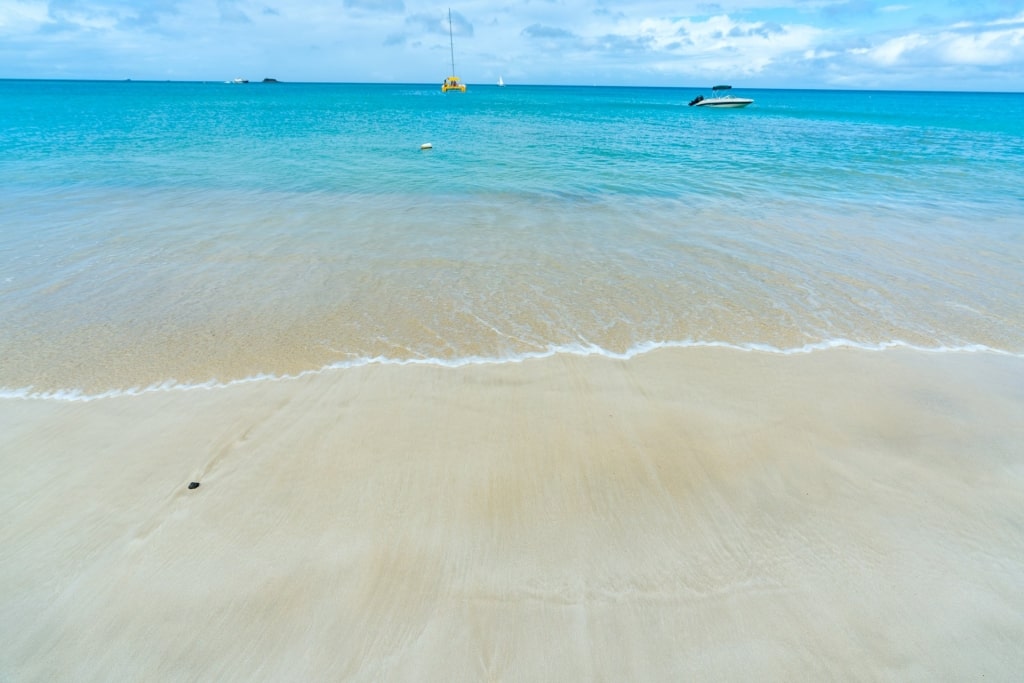
Green Island, Antigua
If you have more time on the island, you’ll want to visit Antigua’s other great spot for Caribbean snorkeling: Green Island. There’s no shortage of incredible beaches on Antigua, but Green Island offers soft sand both above and below the water. Since seagrass grows well on that sandy ocean floor, and green turtles love seagrass, you have a great chance of seeing them here.
You’ll need to take a boat to get to Green Island. It’s a short ride, but it’s not connected to the mainland. The beach is relatively shallow, making it a great place for kids. They can stay just a few feet from the shore and still see marine life, even if they don’t want to go in over their heads.
Read: Best Things to Do in Antigua
Grand Anse Beach, Grenada
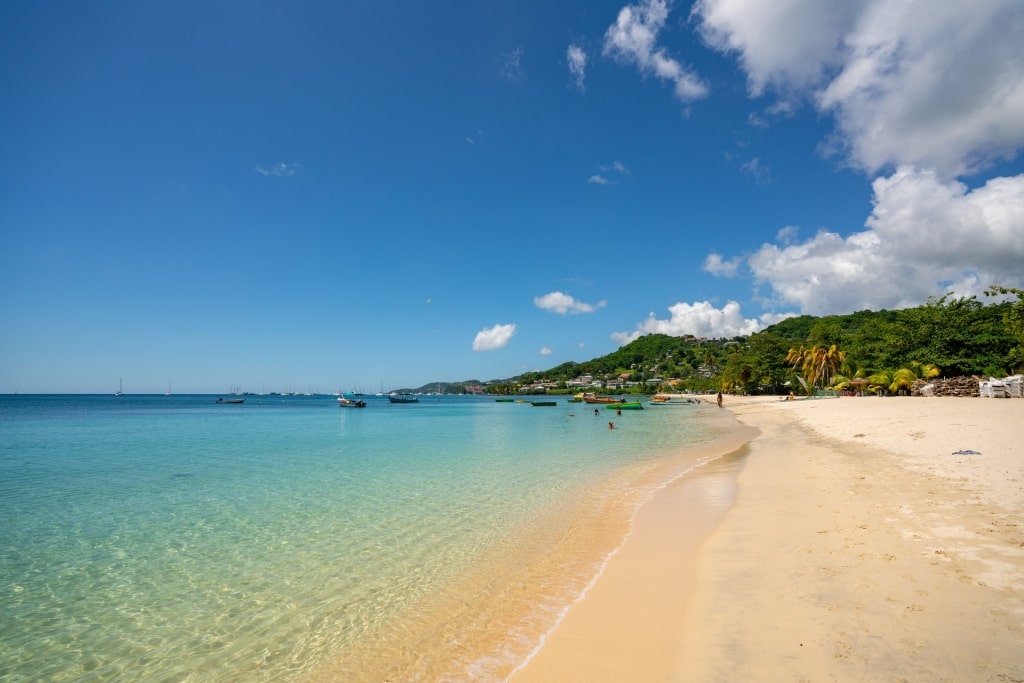
Grand Anse Beach, Grenada
Grand Anse Beach in Grenada is one of the best places to snorkel in the Caribbean since it offers the potential for a great reward with little effort. You’ll find the most marine life around rocks and reefs, but just floating over the sand and watching tiny garden eels pop their heads out from the sand is fun, too.
Not only is this one of the best beaches in Grenada, but it’s also very close to St. George and the port, and you can get in the water from anywhere along the shore. Grand Anse Beach is lined with both restaurants and rental shops, so you don’t need to bring your own snorkel. Snorkel tours often include gear, snacks, and drinks.
Stingray City, Grand Cayman
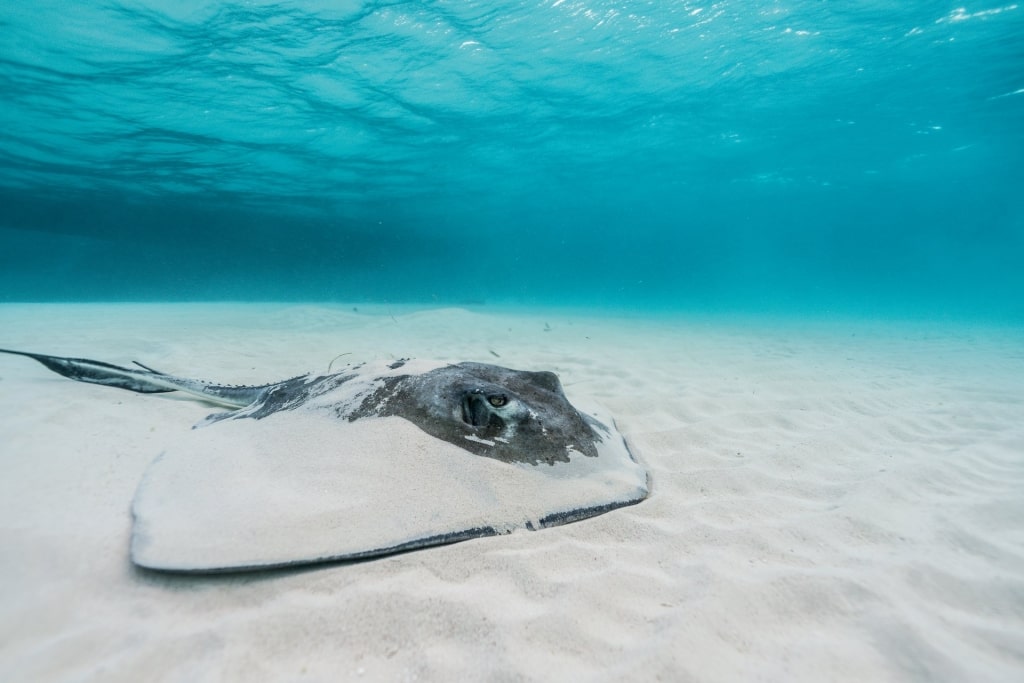
Stingray City, Grand Cayman
If you’re in the mood to swim with some of the most unique creatures on earth, head to Stingray City in Grand Cayman. The stingrays at this snorkel site are very friendly as they’re used to people feeding them. It’s in the open ocean, rather than a contained area, so you don’t need to worry about the stingrays feeling trapped or uncomfortable.
Despite not having many schooling fish at Stingray City, the ability to get near the stingrays makes it one of the best snorkel sites in the Caribbean, especially as it’s very shallow. While you reach it by boat, the water is only three or four feet deep once you arrive at the sandbar. Get a close look at these creatures and be sure to look for the “smiles” on their stomachs when they swim upside-down.
Baths of Virgin Gorda, Tortola
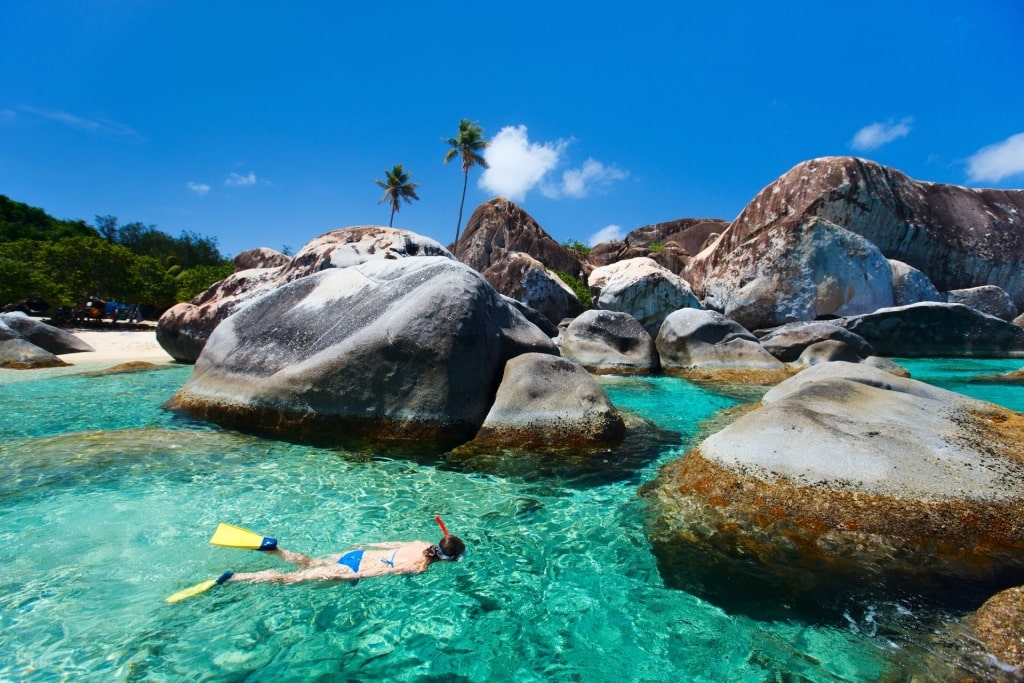
The Baths at Virgin Gorda, Tortola
The Virgin Gorda Baths on Tortola are a stunning series of ocean pools separated by huge boulders. Fish like them, too—the underwater rocks and nooks create the perfect homes for marine life.
While snorkeling, you can stay in the large main pools, snorkel between rocks, or get in further down the beach to find small coves tucked between the rocks. Some of the beach here is a little bit rocky, so throw some water shoes in your day pack to make sure you can stroll wherever you’d like.
Carlisle Beach, Barbados
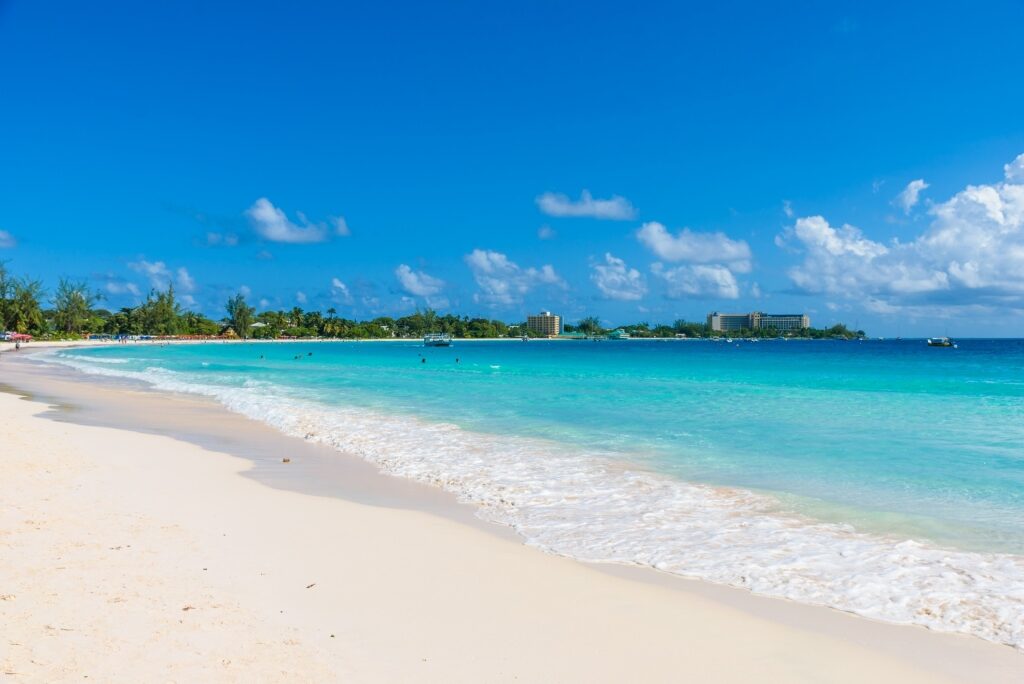
Carlisle Beach, Barbados
Carlisle Beach is part of a marine park, within easy reach of Barbados’ capital, Bridgetown. It’s one of the best beaches in Barbados, but snorkelers can enjoy a quiet break away from the action ashore.
With six shipwrecks of various sizes scattered across the seafloor, this is the perfect spot for snorkeling in Barbados. The coral-encrusted wrecks are interesting in themselves and attract a range of sea life.
Besides the tropical fish, such as sergeant majors, and angelfish, there are usually turtles. Seeing one glide gracefully past is always a thrilling sight.
Guided snorkeling tours are available if you want help with equipment. The guides will enhance the experience with their detailed knowledge of marine life and the history of the wrecks.
Bacalar Lagoon, Costa Maya, Mexico
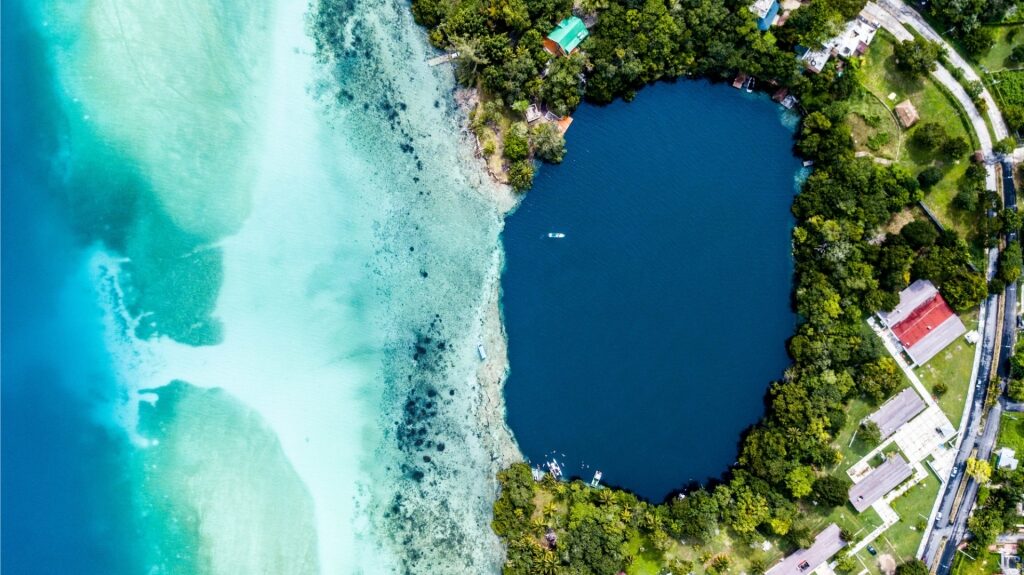
Bacalar Lagoon in Costa Maya, Mexico
Bacalar Lagoon is known as the “Lagoon of Seven Colors” for its many shades of blue. As a freshwater pool, it’s a unique snorkeling experience.
Bacalar is a series of cenotes, deep sinkholes filled with fresh water. You glide among submerged trees, unusual rock formations, and freshwater fish species, making it one of the best places to swim in the world. While it doesn’t have coral, the lagoon is home to stromatolites. These ancient coral-like organisms are a glimpse into Earth’s earliest life forms.
Bacalar’s warm, shallow waters are perfect for beginners and families. Fringed by rich green vegetation, it’s a beautiful, otherworldly place.
Mahahual Reef, Costa Maya, Mexico
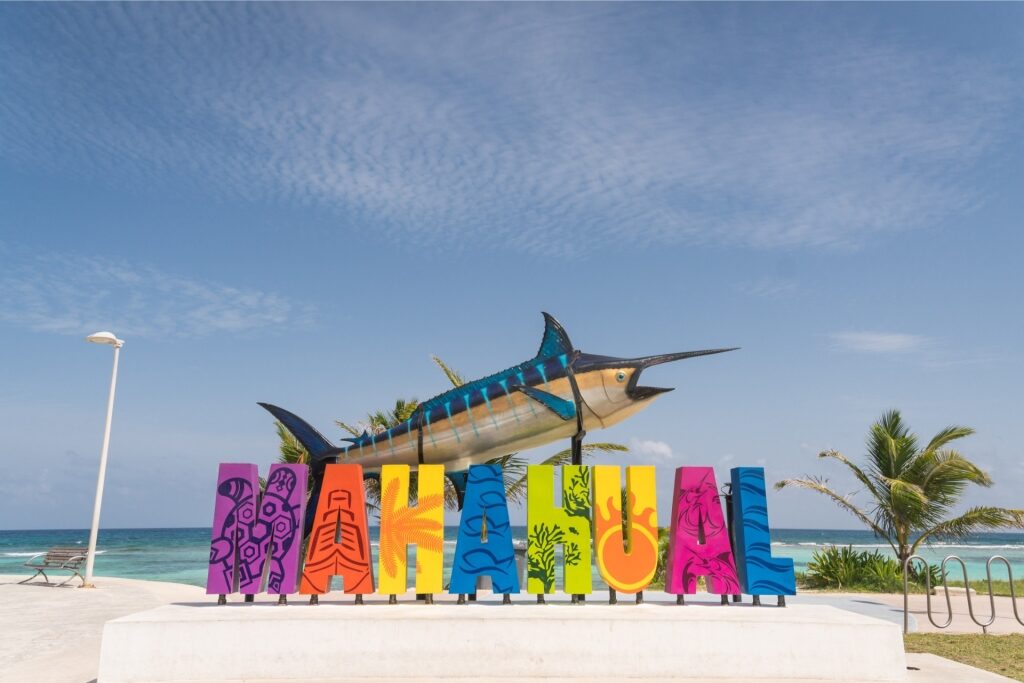
Mahahual in Costa Maya, Mexico
Mahahual Reef in Costa Maya is part of the Mesoamerican Barrier Reef, the world’s second-largest coral reef system. This vibrant ecosystem includes colorful coral formations, sponges, and a wide range of marine life.
You can expect to see parrotfish, angelfish, and sometimes even sea turtles and rays. The water is calm and shallow, with depths ranging from five to 30 feet.
Easily reached from shore, the reef is also a regular stop on boat tours. The clear waters give some of the best snorkeling in the Caribbean. Take a guided tour to learn more about the reef and its marine life. Mahahual encourages eco-friendly tourism and the reef is protected from overuse.
Malmok Beach, Aruba
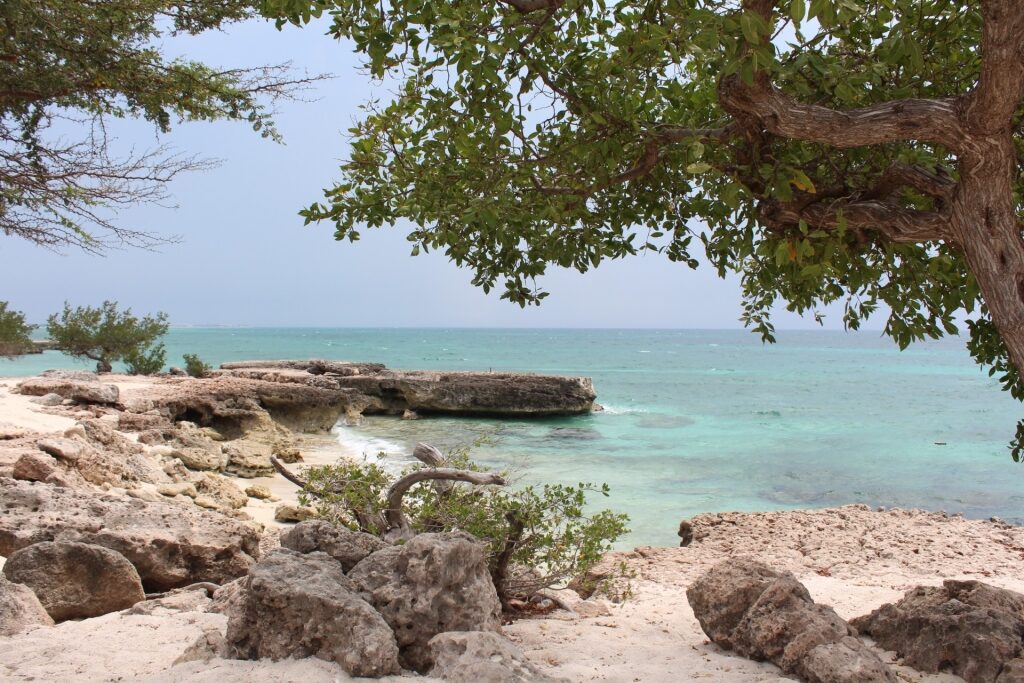
Malmok Beach, Aruba
Malmok Beach is one of Aruba’s best snorkeling spots, a proud boast on an island known for its snorkeling. A rocky shoreline with shallow water gives easy access and keeps the water clear.
Offshore, the coral reef is healthy with abundant marine life. Schools of tropical fish, including butterflyfish and angelfish, are common.
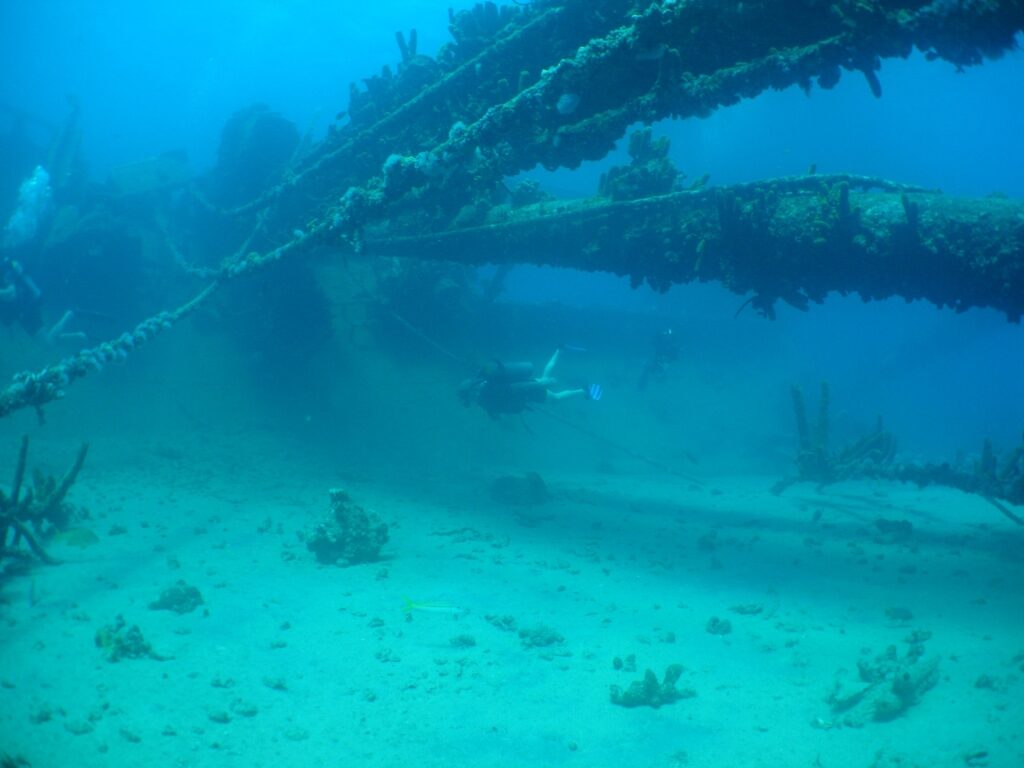
Antilla shipwreck, Aruba
The shallower areas are perfect for beginners, while more experienced snorkelers can explore nooks in the reef. The Antilla shipwreck, accessible by boat, is also a thrilling attraction.
The small beach attracts fewer people than some of Aruba’s bigger ones. That adds to the tranquility of the snorkeling experience, especially early in the morning.
Lac Bay, Bonaire
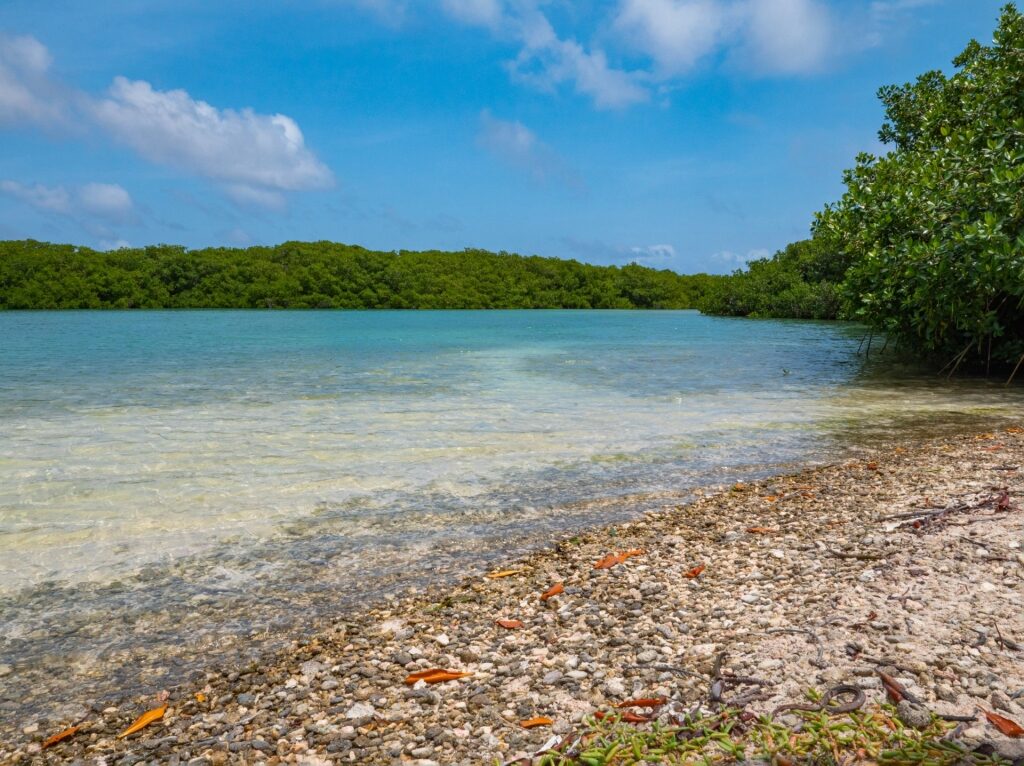
Lac Bay, Bonaire
Lac Bay, on Bonaire’s southeastern coast, is protected by a barrier reef. With its shallow water, this makes the bay a perfect spot for snorkeling.The bay has large seagrass beds where you might spot sea turtles grazing. It’s also a significant habitat for conches.
There is a massive stag horn coral forest where you’ll see species such as blue tang or butterflyfish. Reaching it does mean a long swim out but you should have plenty of fish companions.
With a reputation for eco-friendly tourism, Lac Bay is blessed with clear water. Do keep an eye out for windsurfers, who also love the bay but stay clear of the reef.
Read: Things to Do in Bonaire
Champagne Reef, Dominica
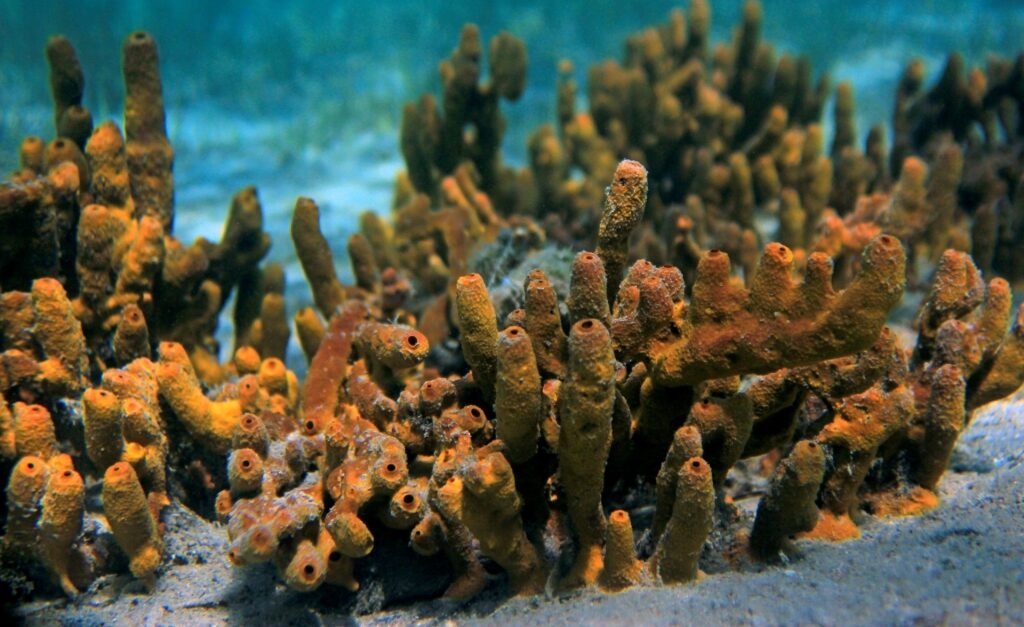
Champagne Reef, Dominica
Snorkeling at Champagne Reef in Dominica is a surreal experience. Geothermal activity creates the bubbles that rise through the ocean floor, hence the name.
This volcanic gas warms the water and attracts many unusual marine species. You’ll see frogfish, seahorses, and maybe even squid or lobsters. The reef itself is rich with colorful coral and sponge formations. With depths ranging from 10 to 40 feet, snorkelers of all levels can find their comfort zone.
Local guides can help explain the geological phenomena and marine life of this unique place. The reef is a popular destination for boat tours, which will supply everything you need to visit.
Molinere Underwater Sculpture Park, Grenada
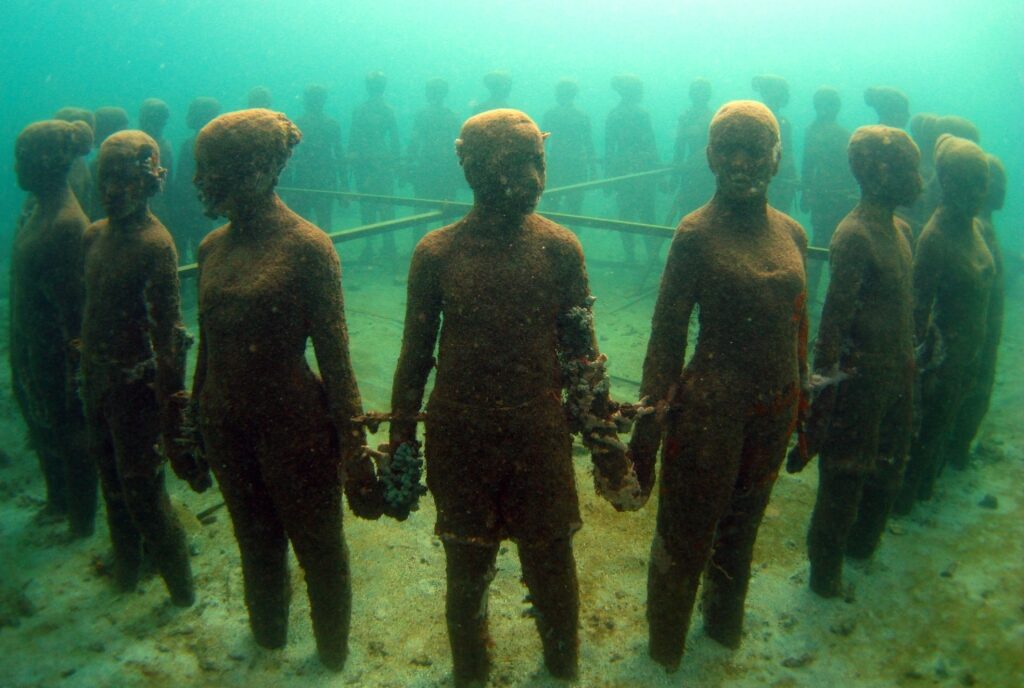
Molinere Underwater Sculpture Park, Grenada
It’s a very special experience to snorkel or dive among the 75 works in Molinere Underwater Sculpture Park. Ranging from a man at a typewriter to a ring of 26 children holding hands, they are all thought-provoking.
Each underwater statue is cast in concrete, whose harshness has been softened by the growth of coral and algae. The project is designed to take pressure off the island’s natural reefs.
Molinere Bay’s clear water has excellent visibility and depths range from six to 15 feet. You can admire the sculptures from the surface or dive down for a closer look.
It’s best to visit the park with a guide, on a boat tour from Grand Anse Bay or St Georges. Guides will be able to describe each of the sculptures, many based on likenesses of local people.
Norman Island, BVI
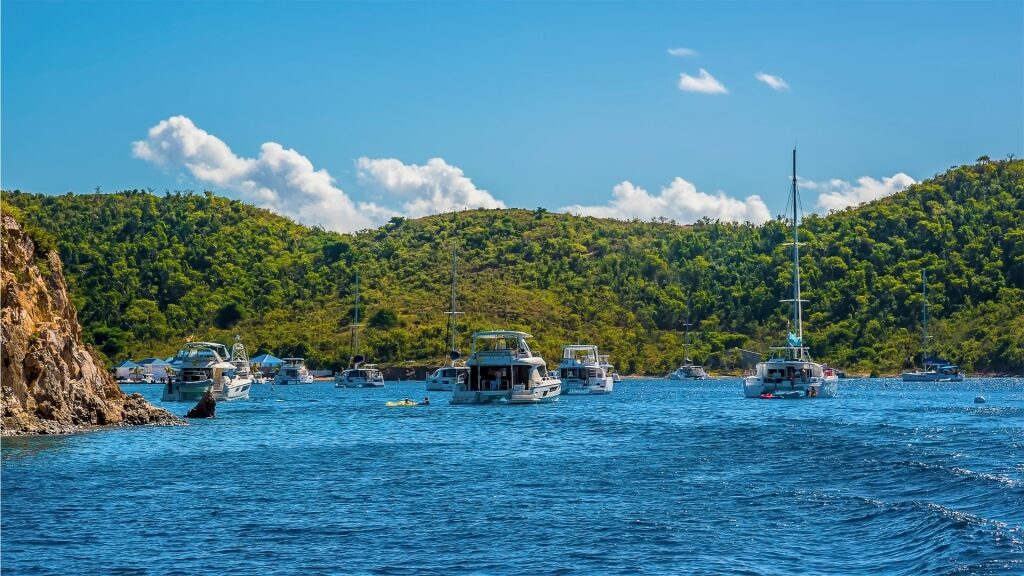
Norman Island, BVI
Norman Island is said to have been the inspiration for the pirate tales of Treasure Island. Its underwater caves could certainly hide a fortune.
Snorkelers can swim into three high, deep caves in the sea cliffs. Filled with schools of fish and shimmering light, they are an evocative experience. The deepest cave turns the experience into something akin to a night dive. It’s easy for the imagination to turn to thoughts of hidden pirate gold.
Norman Island can only be reached on a boat tour from nearby Tortola. The guides will tell you many stories—some even true—of the treasures that have been lost and found on the island.
Cane Bay, St. Croix, USVI
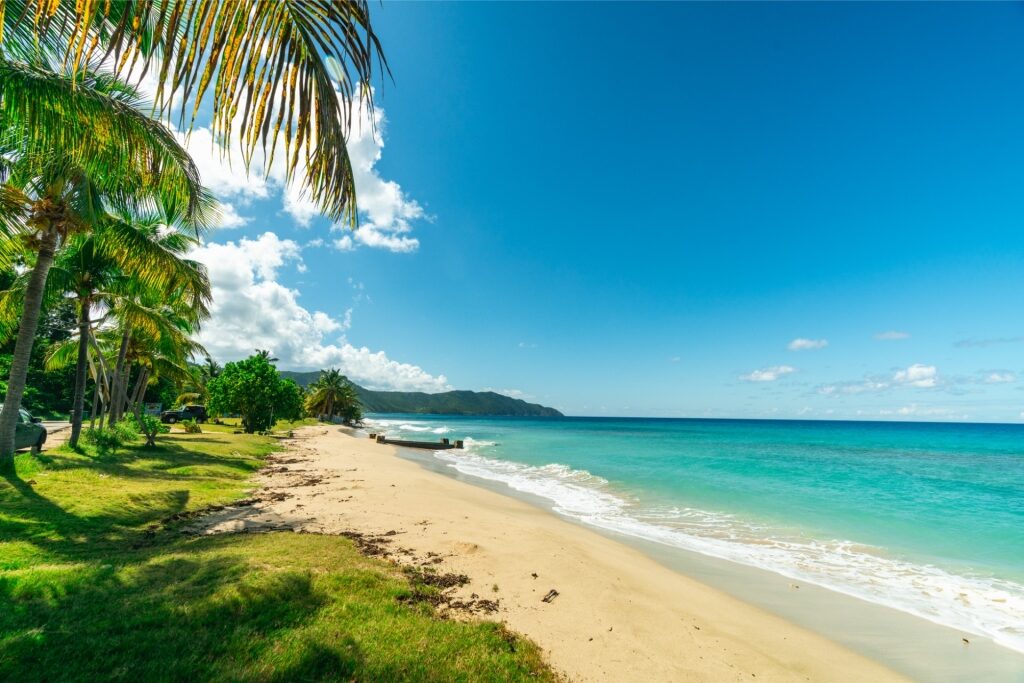
Cane Bay in St. Croix, USVI
Cane Bay, on St. Croix’s north shore, is one of the top snorkeling spots in the U.S. Virgin Islands. The Cane Bay Wall is well known to divers, plunging down a dramatic 13,000 feet.
While such depths are inaccessible even to scuba divers, the shallow reef closer to shore is perfect for snorkeling. You can walk off the shore and soon find yourself among colorful shoals of tropical fish.
The reef is part of a coral protection program and there is abundant marine life. Species from turtles and moray eels, to seahorses and lobster are seen regularly.
The beach—one of the best in St. Croix—has several bars and restaurants. A dive shop will rent scuba equipment as well as snorkel masks and fins.
Gibbs Cay, Grand Turk, Turks & Caicos
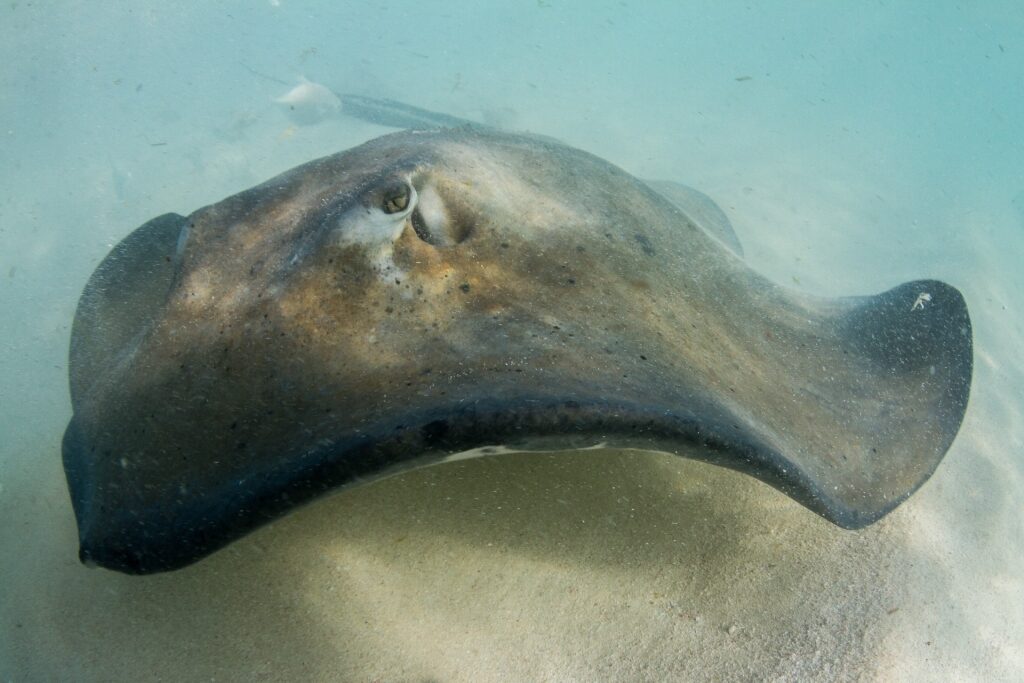
Gibbs Cay in Grand Turk, Turks & Caicos
Gibbs Cay is an uninhabited, seven-acre island one mile off the coast of Grand Turk. It’s famous for the number of placid stingrays seen in its shallow waters.
These stingrays are curious and often approach swimmers, making for some of the best Caribbean snorkeling. The water here is crystal-clear and typically calm, with a depth range of five to 20 feet.
Many tour operators combine a visit to Gibbs Cay with snorkeling trips on the nearby reefs. These are home to a variety of tropical fish, including parrotfish and butterflyfish.
The white sand beach is a perfect place to relax after snorkeling. Tour boats will normally arrange for a lunch and drinks on the beach as part of any tour.
Jalousie Beach, St. Lucia
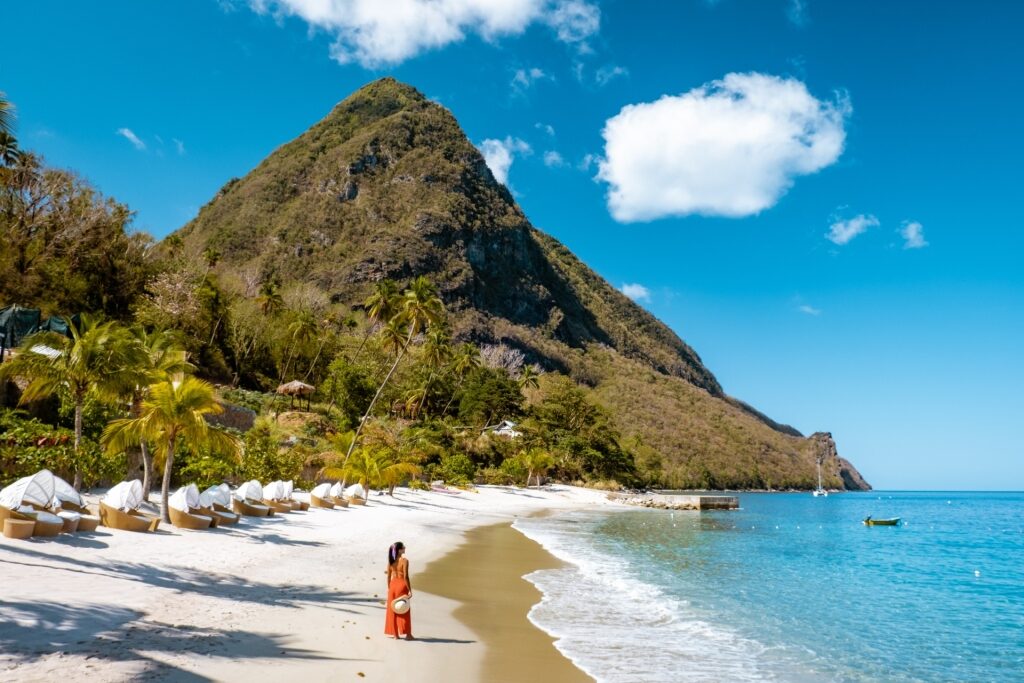
Jalousie Beach, St. Lucia
Jalousie Beach sits between St. Lucia’s iconic Piton mountains. The two volcanic peaks make a dramatic backdrop to any visit to this lovely beach.
Like every beach in St Lucia, Jalousie is a public one. However, it is shared by the Sugar Beach resort, once an 18th-century sugar plantation. You can see why the clear waters and reef life make this an attractive spot for a resort. Enjoy the colorful coral gardens, with sea fans and many large wrasse.
The best way to visit Jalousie is on a catamaran tour that will supply all the snorkel equipment you need. They will also arrange food and drink for a memorable day out.
Palancar Reef, Cozumel, Mexico
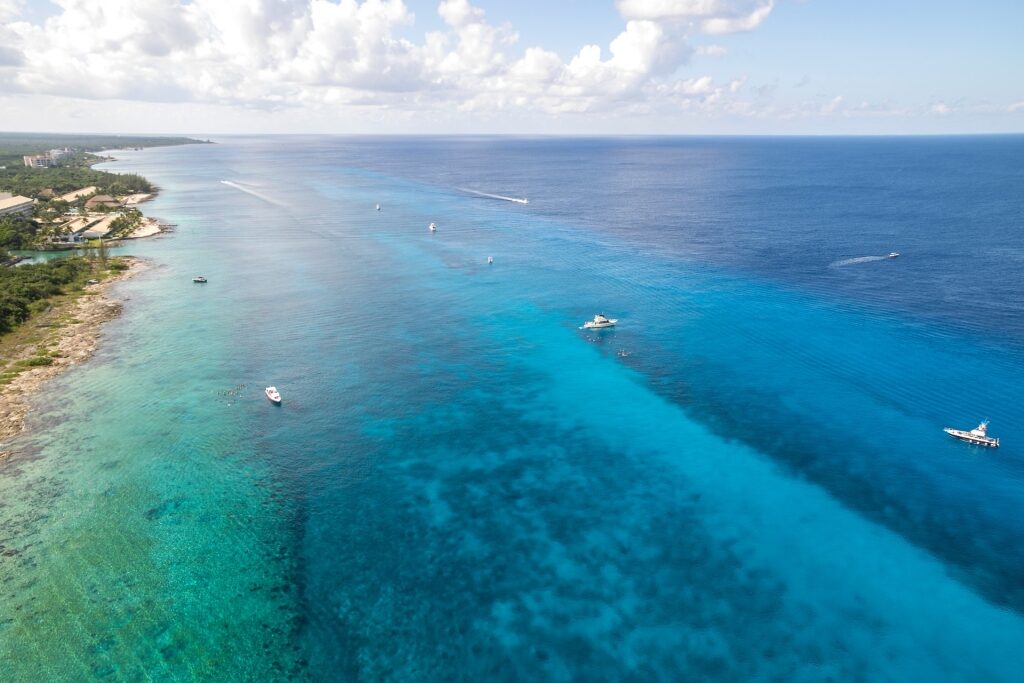
Palancar Reef in Cozumel, Mexico
Palancar Reef is part of the Mesoamerican Barrier Reef. Just off Cozumel’s west coast, it’s one of the Caribbean’s best diving destinations. With its dramatic coral formations, large sponges, tunnels, and overhangs, there is plenty to see. Tour boats will take you to different parts of the reef, each with its own unique features.
The mesmerizing underwater landscape is populated with species such as sea turtles, eagle rays, and moray eels. There is excellent visibility and any underwater camera will be kept busy clicking away.
One highlight is the “starfish sanctuary” where an abundance of starfish dot the sandy seabed. It’s just one among many memorable images you will take away with you.
Doctor’s Cave Beach, Falmouth, Jamaica
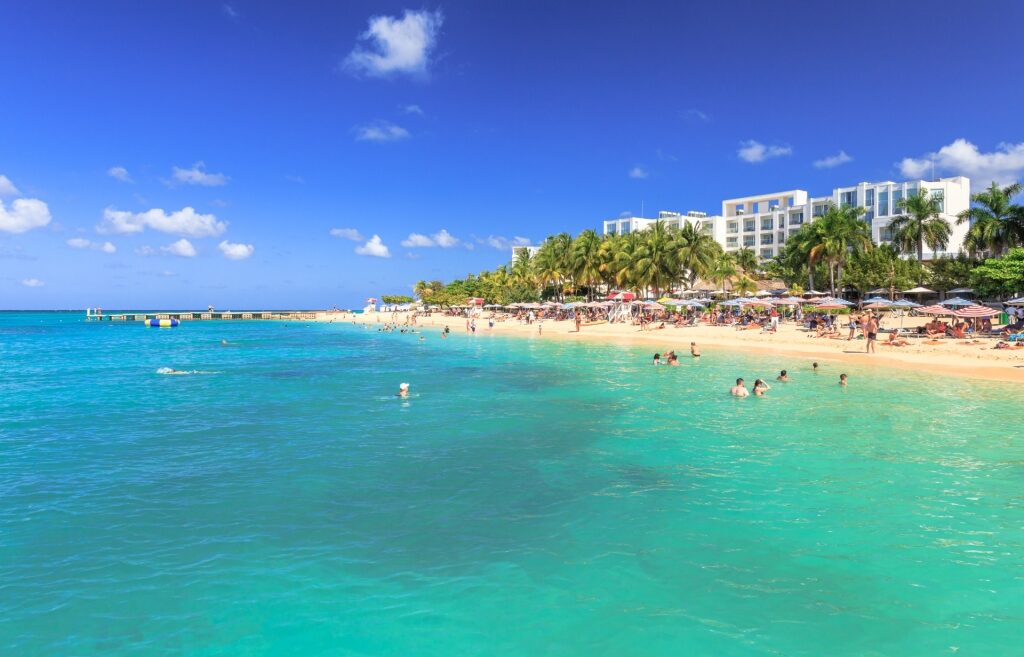
Doctor’s Cave Beach in Falmouth, Jamaica
Doctor’s Cave Beach is one of Jamaica’s most famous beaches. In Montego Bay, not far from Falmouth, it’s part of the Montego Bay Marine Park. This protected area helps preserve the coral reefs and marine life you can see while snorkeling.
Snorkeling here is a delight, with clear, calm waters and a vibrant underwater world just offshore. The healthy coral shimmers with schools of tropical fish. You will see blue tangs, butterflyfish, parrotfish, and the occasional sea turtles.
The warm, mineral-rich waters here are believed to have healing properties, perhaps because of its name. However, that’s actually due to a beach property here being donated to the community by a local doctor.
Anse Noire, Martinique
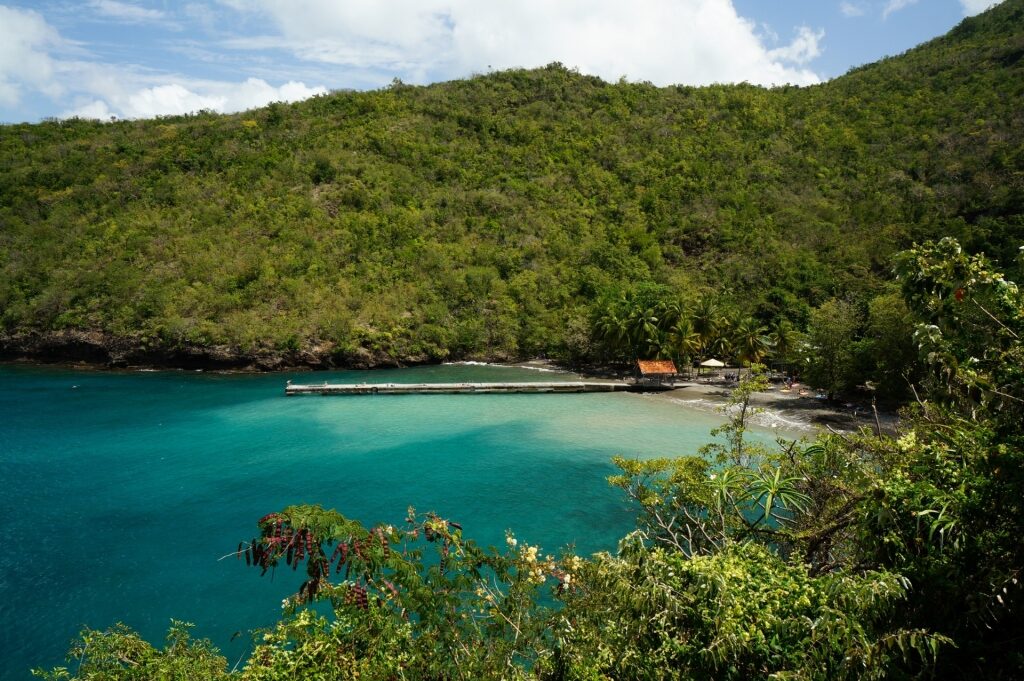
Anse Noire, Martinique
Anse Noire in Martinique is well known for its black sand and excellent snorkeling. Coral reefs just offshore help create clear, calm waters.
However, the beach is relatively uncrowded, partly because it is reached by concrete steps down a steep hillside. Fringed by tropical greenery, it is a beautiful spot. There are no bars or restaurants here, another reason for the beach’s lack of popularity. This quiet spot can feel like an undiscovered slice of paradise.
That black sand can be very hot, so bring sand shoes. They will also protect against rock or coral if you become distracted by the amazing sea life.
Cemetery Beach, Grand Cayman
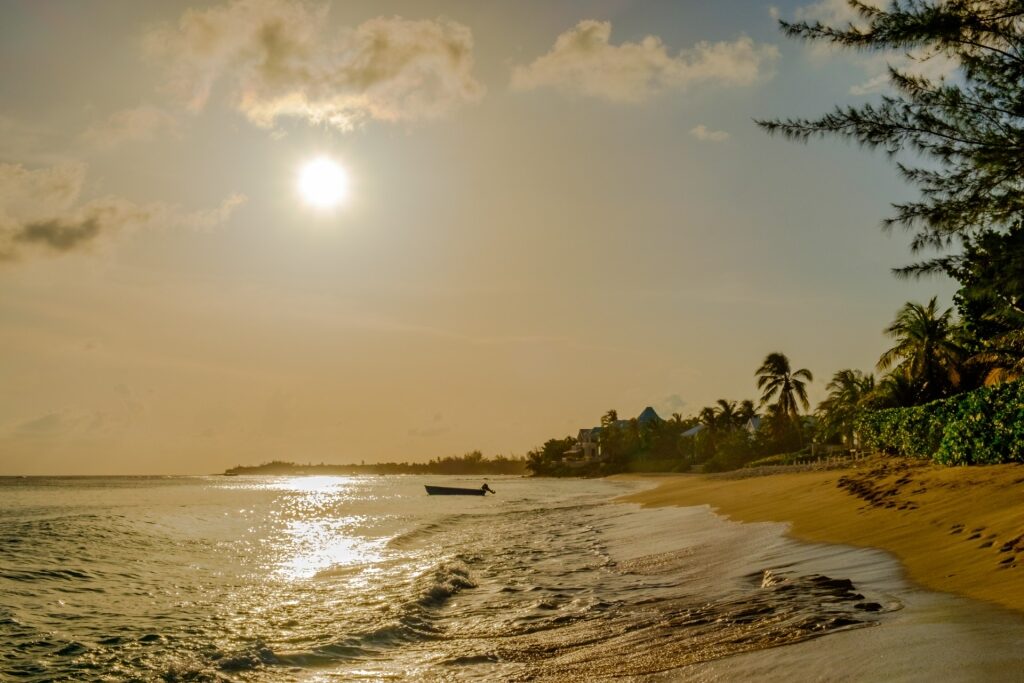
Cemetery Beach, Grand Cayman
Cemetery Beach is at the northern end of Grand Cayman’s famous Seven Mile Beach. It’s named for the picturesque cemetery that runs down to where the sand is.
The Cayman reef lies just offshore, with a depth of 30 feet. The island’s remarkably clear water is at its best on this west coast. You should see plenty of marine life, from parrotfish to eagle rays. Further out is the wreck of the Kittiwake, one of the island’s most popular dive sites.
Seagrape trees around the cemetery provide some welcome shade on this idyllic beach in Grand Cayman. There are no facilities, but there is a supermarket a short drive away.
Coki Beach, St. Thomas
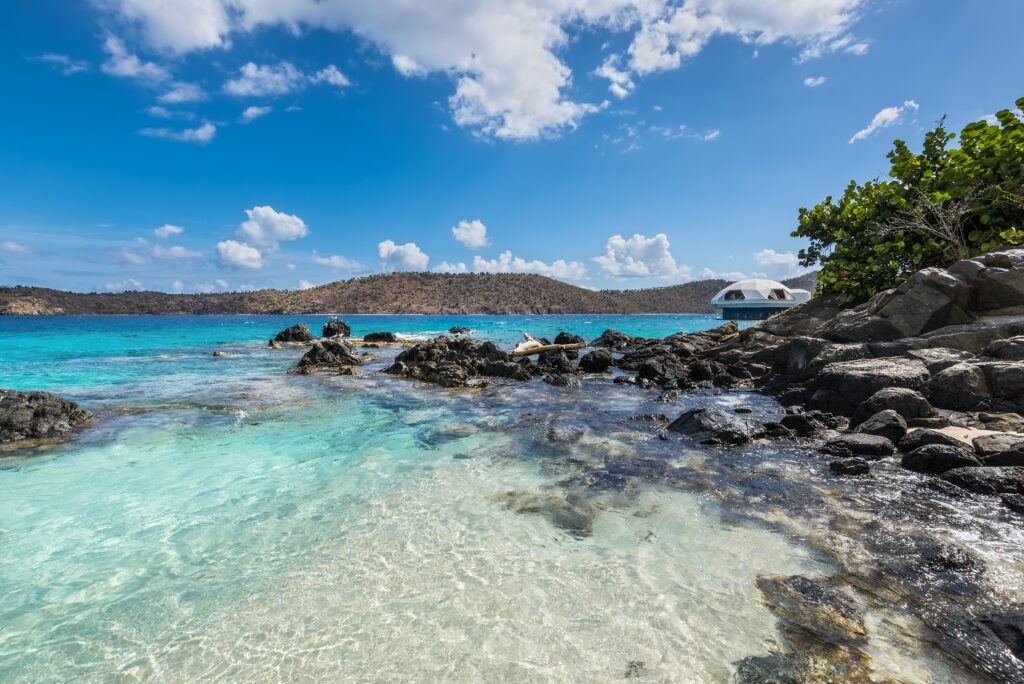
Coki Beach, St. Thomas
Coki Beach is one of the best snorkeling spots in St. Thomas for its coral gardens. The reef, just a short swim from shore, is home to fish who seem to enjoy interacting with swimmers.
You’ll see a wide variety of marine life, including sergeant majors, wrasses, and parrotfish. Sea turtles are also common in the calm, shallow waters.
Conditions close to the shore make Coki Beach ideal for novices, while more experienced swimmers can explore further out. This is a popular beach in St. Thomas, so look out for paddleboarders, kayakers, and other swimmers.
Snorkeling gear can be rented on the beach. The nearby Coral World Ocean Park is the place to learn more about coral.
Sosua Beach, Puerto Plata, Dominican Republic
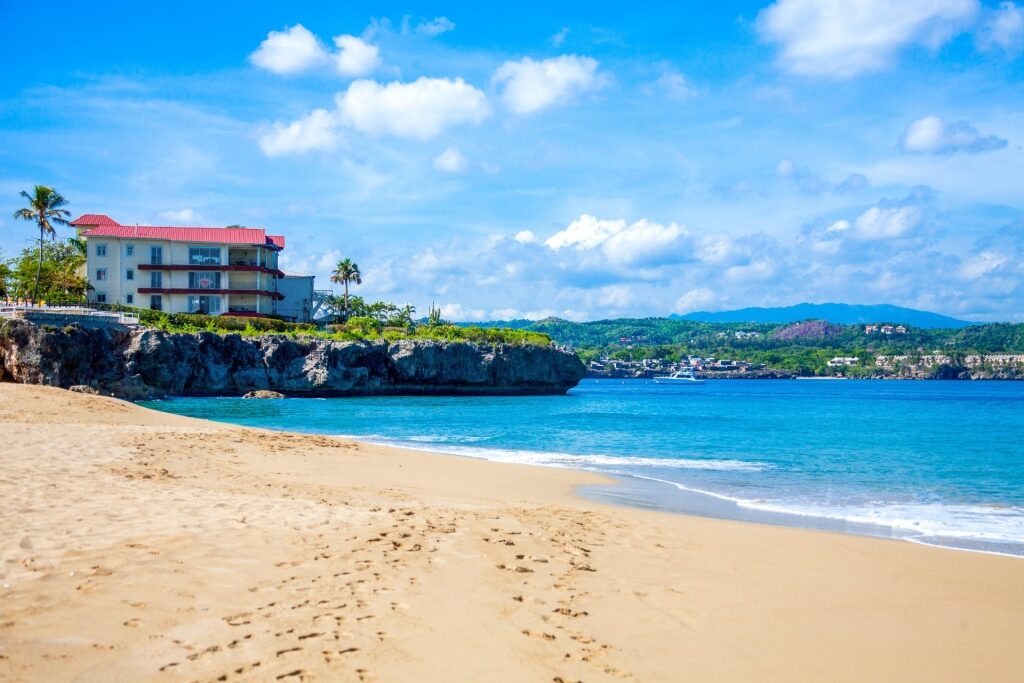
Sosua Beach in Puerto Plata, Dominican Republic
Sosua Beach, on the north coast of the Dominican Republic, has an offshore reef that’s a popular snorkeling spot. Easy to reach from the beach, the coral shimmers with tropical fish.
The calm bay here is ideal for snorkelers of all levels, including complete beginners. Equipment rentals are found on the beach, with guided tours also on offer. The coral formations are healthy, with a wide range of marine life. Expect to see yellowtail snapper, blue tangs, and butterflyfish, among many others.
Sosua Beach has a lively atmosphere, with plenty of beachside restaurants and shops. Relax with some local rum after a snorkeling session and you’ll feel as though you’re in paradise.
Kleine Knip, Curaçao
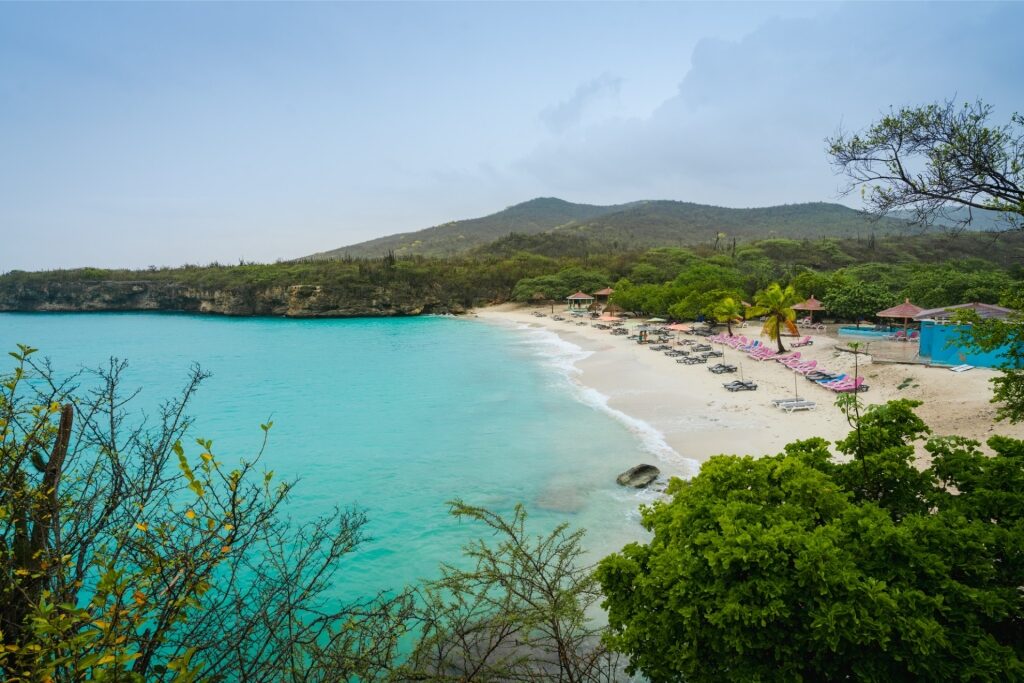
Kleine Knip, Curaçao
Kleine Knip is a “two-for-one” offer with its larger nearby neighbor Grote Knip. Both are beaches on Curacao’s west coast that offer great snorkeling on this calmer side of the island.
Grote Knip fronts a lovely cove within sheltering rocky cliffs. Swim out from the beach along the rocks to see plenty of fish in excellent, clear conditions.
“Little” Knip is much quieter than “Big” Knip, with the latter offering more facilities. With its coral and clear waters, Kleine Knip is where you might see sea turtles.
This smaller beach has better coral than its busier neighbor, especially if you go outside the cozy bay. Both beaches enjoy the warm waters of the island, which make snorkeling here such a popular thing to do in Curacao year-round.
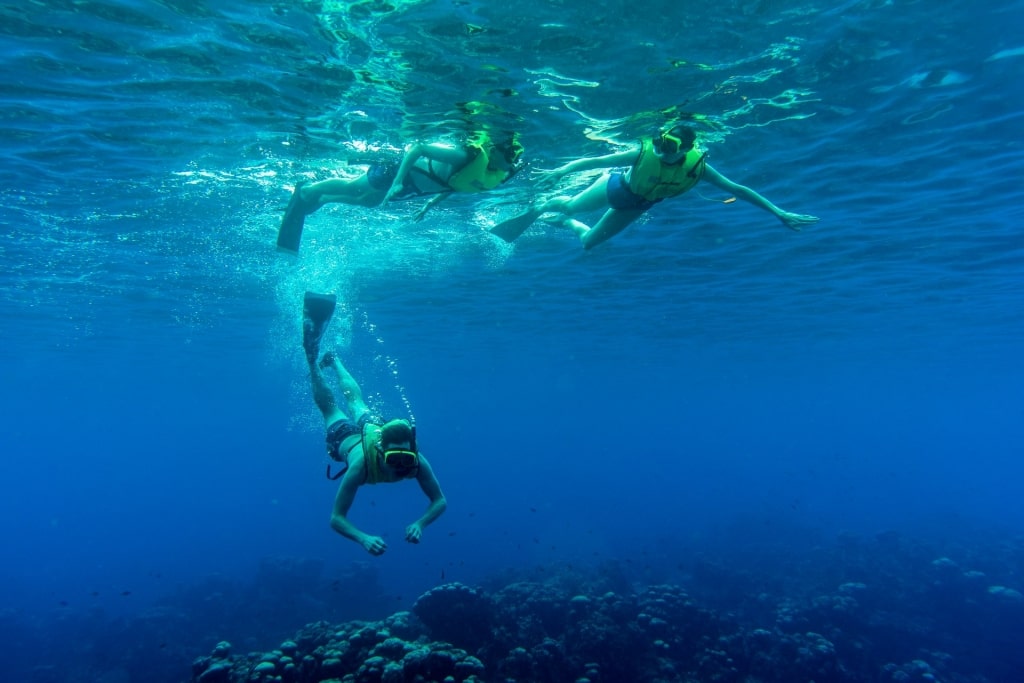
George Town, Grand Cayman
On a cruise to the Caribbean with Celebrity Cruises, you can visit some of the best places to snorkel in the region. Spend your days in the water and your evenings indulging in world-class cuisine, stellar accommodations, and exciting entertainment on board.
Browse cruises on our website and book your next snorkeling adventure today.
